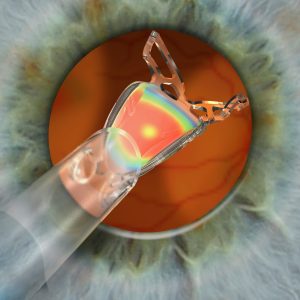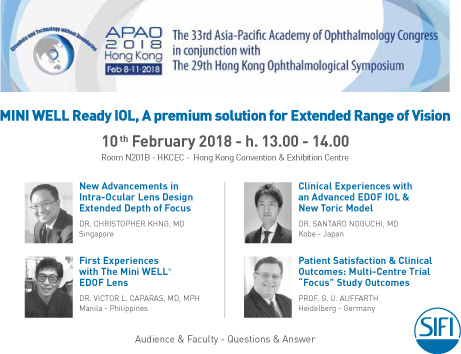APAO 2018, Lunch Symposium - 10 Feb. h. 13:00 - 14:00
33rd Asia-Pacific Academy of Ophthalmology (APAO) Congress
from February 8th to 11th at the Hong Kong Convention & Exhibition Centre (HKCEC)
Don’t miss the SIFI Symposium
MINI WELL Ready IOL, a premium solution for Extended Range of Vision
February 10th from 1-2 PM in Room: N201B
Speakers
Dr. Victor Caparas
Dr. Christopher Khng
Dr. Santaro Noguchi
Prof. Gerd Auffarth
New Advancements in Intra-Ocular Lens Design – Extended Depth of Focus
Christopher Khng, MD – Singapore
First Experiences With The MINI WELL® EDOF Lens
Victor L. Caparas, MD, MPH – Manila, Philippines
Experiences with a Polyfocal EDOF IOL & New Toric Model
Santaro Noguchi, MD – Kobe, Japan
Patient Satisfaction & Clinical Outcomes: Multi-Centre Trial – “Focus” Study Outcomes
Prof. G. U. Auffarth – Heidelberg, Germany
About Mini WELL IOL
 MINI Well design is of a foldable preloaded Intraocular Lens (IOL) used, to replace the human crystalline after cataract surgery, for an innovative treatment of presbyopia disease in adult patients. MINI Well is an acronym for Wavefront Engineered Leading Lens and evokes the wellness of vision providing to the implanted patient.
MINI Well design is of a foldable preloaded Intraocular Lens (IOL) used, to replace the human crystalline after cataract surgery, for an innovative treatment of presbyopia disease in adult patients. MINI Well is an acronym for Wavefront Engineered Leading Lens and evokes the wellness of vision providing to the implanted patient.
MINI Well has a wavefront engineered design applying recent discoveries in optical science and by changing pupil optical properties getting an efficient progressive visual performance.
As a preloaded lens, MINI Well is ready to be folded and injected in the eye during a mini invasive cataract Surgery.
MINI Well for a simple and safe presbyopia correction changes the pupil optical properties getting an efficient progressive visual performance. MINI Well is commercially available in Europe and has received a CE Approval (Number of Approval Cerficate: n° G1 12 11 77201 004) by the approving body: TUV SUD PRODUCT SERVICE GMBH
EDOF optics
Mini WELL IOL provides a progressive, extended depth of- focus (EDOF) experience for patients – not just a few sharp foci.
How does the SIFI Mini WELL work to give progressive depth of focus?
By having two concentric central zones with spherical aberrations of opposite sign, and an external monofocal zone.
The key concept is that it doesn’t use the diffractive principle of having different foci. Instead, the lens optics has zones of different asphericity with a refractive central zone that translates to around 2.5 D in near, with optically efficient transition zones, to give a good quality of vision across all distances .
Dr. Carmelo Chines
Direttore responsabile

